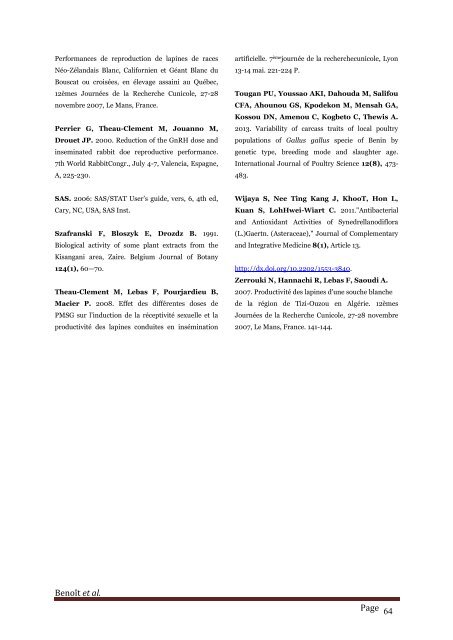Valuation of Synedrella nodiflora leaves in rabbit feeding as feed supplement: impact on reproductive performance
Abstract The current study aims to evaluate the effect of Synedrellanodiflora leaves used as feed supplement in the diet of rabbits on their reproductive performances. Then, 96 rabbits (80 primiparous females and 16 males)of Common breed were divided into 4 lots and subjected to different dietary treatments. In lot1, only the female rabbits had received Synedrellanodiflora leaves. In lot 2, both males and females were all fed with Synedrellanodiflora. In lot 3, only the males were fed Synedrellanodiflora, while in lot 4 (control group) neither males nor females were fed with Synedrellanodiflora. It appears that the highest litter size (P˂0.001) was recorded in lot 1 and lot 2. At weaning, the highest litter size was recorded in lot 2 (P˂0.001). The live weight at 25 and 35 days old in kits of lots 3 and lot 4 were higher than those recorded in lots 1 and 2 (P˂0.001). The fertility rateof lot 3 was 100% to 80%, 89% and 70% respectively for lot 1, 2 and 4 (P˂0.001). The kidding rate was 100% in lots 1, 2 and 4 to 88% in lot 3. Similarly, the highest stillbirth rate was recorded in lot 3 (P˂0.001). Synedrellanodifloraleaveshad reduced the mortality rate from the birth to the weaning from 14% to 3.4% with the highest rate observed in the control group (P˂0.001).Overall, Synedrellanodiflora leaves using as feed supplement in rabbits improves fertility rate and litter size, and reduces significantly the mortality rate from birth to weaning.
Abstract
The current study aims to evaluate the effect of Synedrellanodiflora leaves used as feed supplement in the diet of rabbits on their reproductive performances. Then, 96 rabbits (80 primiparous females and 16 males)of Common breed were divided into 4 lots and subjected to different dietary treatments. In lot1, only the female rabbits had received Synedrellanodiflora leaves. In lot 2, both males and females were all fed with Synedrellanodiflora. In lot 3, only the males were fed Synedrellanodiflora, while in lot 4 (control group) neither males nor females were fed with Synedrellanodiflora. It appears that the highest litter size (P˂0.001) was recorded in lot 1 and lot 2. At weaning, the highest litter size was recorded in lot 2 (P˂0.001). The live weight at 25 and 35 days old in kits of lots 3 and lot 4 were higher than those recorded in lots 1 and 2 (P˂0.001). The fertility rateof lot 3 was 100% to 80%, 89% and 70% respectively for lot 1, 2 and 4 (P˂0.001). The kidding rate was 100% in lots 1, 2 and 4 to 88% in lot 3. Similarly, the highest stillbirth rate was recorded in lot 3 (P˂0.001). Synedrellanodifloraleaveshad
reduced the mortality rate from the birth to the weaning from 14% to 3.4% with the highest rate observed in the control group (P˂0.001).Overall, Synedrellanodiflora leaves using as feed supplement in rabbits improves fertility rate and litter size, and reduces significantly the mortality rate from birth to weaning.
Create successful ePaper yourself
Turn your PDF publications into a flip-book with our unique Google optimized e-Paper software.
Performances de reproducti<strong>on</strong> de lap<str<strong>on</strong>g>in</str<strong>on</strong>g>es de races<br />
Néo-Zélandais Blanc, Californien et Géant Blanc du<br />
Bouscat ou croisées, en élevage <str<strong>on</strong>g>as</str<strong>on</strong>g>sa<str<strong>on</strong>g>in</str<strong>on</strong>g>i au Québec,<br />
12èmes Journées de la Recherche Cunicole, 27-28<br />
novembre 2007, Le Mans, France.<br />
Perrier G, Theau-Clement M, Jouanno M,<br />
Drouet JP. 2000. Reducti<strong>on</strong> <str<strong>on</strong>g>of</str<strong>on</strong>g> the GnRH dose and<br />
<str<strong>on</strong>g>in</str<strong>on</strong>g>sem<str<strong>on</strong>g>in</str<strong>on</strong>g>ated <str<strong>on</strong>g>rabbit</str<strong>on</strong>g> doe <strong>reproductive</strong> <strong>performance</strong>.<br />
7th World RabbitC<strong>on</strong>gr., July 4-7, Valencia, Espagne,<br />
A, 225-230.<br />
artificielle. 7 ème journée de la recherchecunicole, Ly<strong>on</strong><br />
13-14 mai. 221-224 P.<br />
Tougan PU, Youssao AKI, Dahouda M, Salifou<br />
CFA, Ahounou GS, Kpodek<strong>on</strong> M, Mensah GA,<br />
Kossou DN, Amenou C, Kogbeto C, Thewis A.<br />
2013. Variability <str<strong>on</strong>g>of</str<strong>on</strong>g> carc<str<strong>on</strong>g>as</str<strong>on</strong>g>s traits <str<strong>on</strong>g>of</str<strong>on</strong>g> local poultry<br />
populati<strong>on</strong>s <str<strong>on</strong>g>of</str<strong>on</strong>g> Gallus gallus specie <str<strong>on</strong>g>of</str<strong>on</strong>g> Ben<str<strong>on</strong>g>in</str<strong>on</strong>g> by<br />
genetic type, breed<str<strong>on</strong>g>in</str<strong>on</strong>g>g mode and slaughter age.<br />
Internati<strong>on</strong>al Journal <str<strong>on</strong>g>of</str<strong>on</strong>g> Poultry Science 12(8), 473-<br />
483.<br />
SAS. 2006: SAS/STAT User’s guide, vers, 6, 4th ed,<br />
Cary, NC, USA, SAS Inst.<br />
Szafranski F, Bloszyk E, Drozdz B. 1991.<br />
Biological activity <str<strong>on</strong>g>of</str<strong>on</strong>g> some plant extracts from the<br />
Kisangani area, Zaire. Belgium Journal <str<strong>on</strong>g>of</str<strong>on</strong>g> Botany<br />
124(1), 60—70.<br />
Theau-Clement M, Leb<str<strong>on</strong>g>as</str<strong>on</strong>g> F, Pourjardieu B,<br />
Macier P. 2008. Effet des différentes doses de<br />
PMSG sur l’<str<strong>on</strong>g>in</str<strong>on</strong>g>ducti<strong>on</strong> de la réceptivité sexuelle et la<br />
productivité des lap<str<strong>on</strong>g>in</str<strong>on</strong>g>es c<strong>on</strong>duites en <str<strong>on</strong>g>in</str<strong>on</strong>g>sém<str<strong>on</strong>g>in</str<strong>on</strong>g>ati<strong>on</strong><br />
Wijaya S, Nee T<str<strong>on</strong>g>in</str<strong>on</strong>g>g Kang J, KhooT, H<strong>on</strong> L,<br />
Kuan S, LohHwei-Wiart C. 2011."Antibacterial<br />
and Antioxidant Activities <str<strong>on</strong>g>of</str<strong>on</strong>g> <str<strong>on</strong>g>Synedrella</str<strong>on</strong>g><str<strong>on</strong>g>nodiflora</str<strong>on</strong>g><br />
(L.)Gaertn. (Asteraceae)," Journal <str<strong>on</strong>g>of</str<strong>on</strong>g> Complementary<br />
and Integrative Medic<str<strong>on</strong>g>in</str<strong>on</strong>g>e 8(1), Article 13.<br />
http://dx.doi.org/10.2202/1553-3840.<br />
Zerrouki N, Hannachi R, Leb<str<strong>on</strong>g>as</str<strong>on</strong>g> F, Saoudi A.<br />
2007. Productivité des lap<str<strong>on</strong>g>in</str<strong>on</strong>g>es d'une souche blanche<br />
de la régi<strong>on</strong> de Tizi-Ouzou en Algérie. 12èmes<br />
Journées de la Recherche Cunicole, 27-28 novembre<br />
2007, Le Mans, France. 141-144.<br />
Benoît et al.<br />
Page 64





![Review on: impact of seed rates and method of sowing on yield and yield related traits of Teff [Eragrostis teff (Zucc.) Trotter] | IJAAR @yumpu](https://documents.yumpu.com/000/066/025/853/c0a2f1eefa2ed71422e741fbc2b37a5fd6200cb1/6b7767675149533469736965546e4c6a4e57325054773d3d/4f6e6531383245617a537a49397878747846574858513d3d.jpg?AWSAccessKeyId=AKIAICNEWSPSEKTJ5M3Q&Expires=1717484400&Signature=JD8GlvTph%2BdedX0c4tErbVpK13g%3D)












